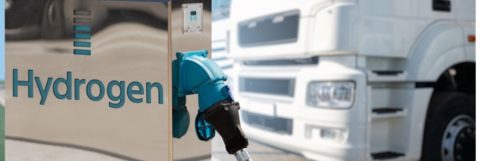On Thursday, Oct. 6, FORVIA hosted a discussion with industry experts about the role hydrogen is expected to play in powering the future of transportation in celebration of National Hydrogen Day and Fuel Cell Day. The panel was moderated by MichAuto executive director Glenn Stevens Jr. and featured:
- Sumanth Addagarla, President, BayoTech Inc.
- Jordan Choby, Vice President, Powertrain Control, Toyota Motor North America R&D
- Rob Del Core, General Manager, Symbio
- Reuben Sarkar, President and Chief Executive Officer, American Center for Mobility
- Tarek Abdel-Baset, Hydrogen Storage Systems Chief Engineer, Zero Emissions, FORVIA
Stevens opened the conversation by asking where hydrogen is positioned with other ICE alternatives on the market. Abdel-Baset said that while there used to be a battle between battery and hydrogen, hydrogen is now seen as having comparable advantages that give it a strong business case in many areas.
Del Core added that after many years of “pushing rocks uphill” to get movement behind hydrogen, it’s satisfying to see its value recognized. Not only is hydrogen a renewable fuel that can be made from a wide variety of sources such as wind, solar, hydro, and nuclear, but it can be created locally or remotely and stored until needed.
“It’s becoming clear now that hydrogen is the only fuel that can couple both the transportation and energy sectors,” he said. “It can decarbonize both sectors, too. It also helps stabilize and provide resilience in communities.”
Choby echoed that a core advantage of hydrogen is its ability to be easily transported “off-highway” to commercial vehicle work locations. Because of this, commercial vehicles and long-haul trucks appear to hold the most promise for the early adoption of fuel-cell propulsion.
“There is a huge variety and diversity of applications that are driving the use of hydrogen,” said Addagarla, including cell towers that are typically located high on top of hills. A simple pickup truck can easily transport hydrogen to that location.
When asked what needs to happen from an infrastructure standpoint, Abdel-Baset said it’s important to hammer down the costs to reach a critical threshold of fueling stations. Once this is met, end-users of the technology can begin trying it out and become comfortable with the idea of adopting the technology. Sarkar agreed that while demand will ultimately drive hydrogen’s success, demonstration programs are an important catalyst.
Regarding talent and workforce, Del Core shared that Symbio has been engaging with California universities and technical colleges to create curriculum and course material to train the next generation of technicians and engineers. This program, called the Symbio Academy, is also used to upskill their current team members.
Wrapping up the conversation, Del Core said, “friendly competition is needed to advance the technology, and we’re seeing that right now. It’s a matter of dedication and focus. If we can send people to the moon with a decade of dedication, we can do the same thing here with hydrogen.”

